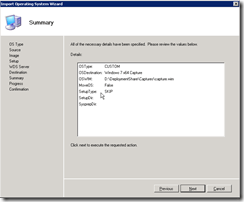Microsoft Deployment Toolkit 2010 has some nice improvements to handle drivers. I will describe how I like to manage drivers in MDT 2010.
Some time I wrote i article about how to get the Name & Model from a computer. This is very important when you want to import only the right drivers automatically.
First we have to build the ‘Out-of-Box Drivers’ folder structure and import drivers. I have subdirectories for each architecture, brand and model. This is what my folder tree looks like:

However, you can build your own structure, as long as you respect the proper model & brand (make) name of the vendors.
Build Out-of-Box Drivers tree
To build up the folder structure you have to know the model name of your hardware. To retrieve the proper computer name execute at powershell command prompt: ‘Get-WmiObject -Class win32_computersystemproduct | fl Name,Model,UUID,Identifyingnumber,Vendor’, to get the exact name WMI queries to determine the computer model. In my case the computer name is “Latitude D830”.
Now that we have drivers imported in our Deployment Share, it’s time to move on.
1. DriverGroups
DriverGroups existed in MDT 2008 already, although the MDT Team added subdirectory support in MDT 2010.
At deployment phase MDT uses WMI to query the proper computer model and only the current model drivers will be injected. In order to get this working properly, you have to use the EXACT model name in your Out-of-Box Driver tree.
Inject the correct drivers in your Task Sequence
Add a new step in your Task Sequence to inject the correct drivers. MDT will query the computer name and inject the drivers which corresponds with the computer name from the Out-of-Box folder structure, right before applying the image at deployment.


I use ‘DriverGroup_001’ as Task Sequence Variable, and Win7×64\%Make%\%Model% as value for my Windows 7 x64. You have to adapt this to your Out-of-Box tree.

As I use a DriverGroup I’ve disabled the ‘Inject Drivers’ task.
Customsettings.ini
As my Task Sequence handles everything, there isn’t anything needed here.
If you don’t like to use a new Task in your TS, you can add DriverGroup variables in customsettings.ini like this:
DriverGroup_001=%Make%\%Model%
DriverGroup_002=Printers
2. Selection Profiles
New in MDT 2010 are DriverSelectionProfiles. These are easy for new MDT admins, very straight forward and easy to use.
Overview:

First you have to create a Profile (or use one of the default profiles):

You can even select Packages and Applications, use it for “bad drivers” aka driver setup packs.
Select what drivers you want to add to the profile;

After making the profiles you can use them in your Task Sequences. The default ‘Inject Drivers’ settings are on the left, the customized one on the right:


You can add Selection Profiles for drivers/packages or whatever you want. Just add an extra step in your task sequence like above.
Customsettings.ini
As with DriverGroups you can choose to handle the DriverSelectionProfile in customsettings.ini or in your TS.
Example:
DriverSelectionProfile=Dell Latitude D520 x64
Like this:
Like Loading...

![]()



























